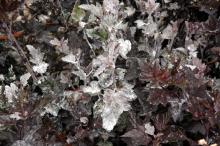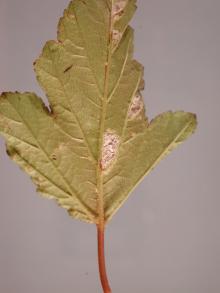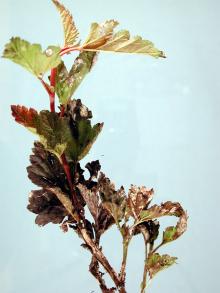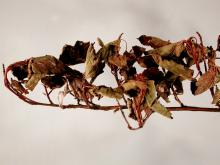See:
Greenhouse Plants, Ornamental - Powdery Mildew
Cause The fungus Podosphaera physocarpi is reported to infect eastern ninebark (Physocarpus opulifolius) grown in Oregon. The OSU Plant Clinic has detected this disease on eastern ninebark. The green foliage cultivar Nanus did not develop colonies in a two-year study in CT. The purple foliage cultivars Seward Summer Wine and the yellow foliage cultivar Luteus get the disease but are considered resistant. Highly susceptible cultivars include Dart's Gold, Morning Star, and Nugget. Powdery mildew is also suspected to occur on Pacific ninebark (P. capitatus).
This fungus is favored by conditions that produce high humidity but dry leaves. It is a highly specialized pathogen that forms a close association with the host. Conditions that favor the host also favor the pathogen. Much of the fungus remains outside infected plant parts where it grows on the surface but sinks root-like structures called haustoria into plant cells to obtain nutrients. The white growth seen is composed of both mycelium and fungal spores.
Symptoms White superficial powdery colonies on leaves, stems, inflorescences and infructescences. Witches' brooms consisting of light pink to white colored, thickened shoots with stunted leaves also occur. Heavy brooming and colonization of leaves can lead to premature defoliation. The disease is more noticeable on purple foliage plants.
Cultural control
- Grow resistant cultivars.
- Space plants for good air circulation.
- Plant in full sun.
Chemical control Many ornamental labels will support the use if they are not phytotoxic to the plants.
- Armada 50 WDG at 3 to 9 oz/100 gal water. Do not use a silicone-based surfactant. Not for nursery or greenhouse use. Group 3 + 11 fungicide. 12-hr reentry.
- Myclobutanil 20 EW T&O at 6 to 12 fl oz/100 gal water plus spreading agent. May observe a PGR effect. Group 3 fungicide. 24-hr reentry.
- Seido at 4 to 5 fl oz/100 gal water plus an adjuvant. Group 50 fungicide. 4-hr reentry.
Note Do not use Insignia or Pageant as injury may occur.
Reference Lubell, J.D., Brand, M.H. and Lehrer, J.M. 2011. Susceptibility of eastern ninebark (Physocarpus opulifolius (L.) Maxim.) cultivars to powdery mildew. Journal of Environmental Horticulture 29:105-107.





